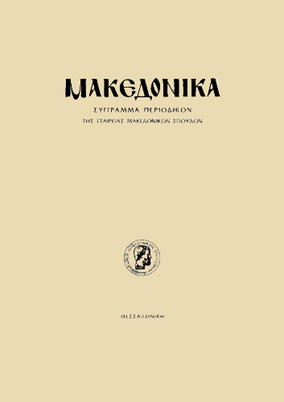Θαυματουργικές εικόνες της Μονής Βατοπαιδίου και τα αντίγραφα τους
Part of : Μακεδονικά ; Vol.36, 2007, pages 1-31
Issue:
Pages:
1-31
Parallel Title:
Miraculous icons of the Vatopedi Monastery and their copies.
Section Title:
Articles
Abstract:
In the present study we mention three icons of the Vatopedi monasteryof Mount Athos, which are venerated as miraculous. The icons in question areof the Virgin Vematarissa, the Virgin Paramythia and the Virgin Antiphonetria. These icons are especially popular and have been the model for a seriesof copies.The icon of the Virgin Vematarissa (fig. 1-3) ia connected, according to thetradition, to a raid and plunder of the monastery by the Arabs in the 10th century. It is also named «Ktetorissa» because of its miraculous discovery during theperiod in which the three founders of the monastery lived (end of the 10th century). In later copies it also bears the name «Vathopedini», «Vatopedini or Vematarissa» or «Vematarissa of Vatopedi». Iconographically, it follows the type ofthe Virgin Odegetria. It bears silver and gold revetment, which consists of partschronologically covering the period from the second half of the 12th century tothe 19th century. An inscription, preserved in the twelfth-century revetment,gives us information about the icon being a donation of the hegumene of themonastery of Theosteriktos (end of the 12th century). In addition, according toan inscription, some parts of the revetment can be dated back to the 14th century and some others to the 1690s, being the work of the goldsmith Nikolaosfrom Nikolitza. The icon of the Virgin Vematarissa has been the model for anumber of copies, seven of which are kept in the monastery and are dated fromthe last quarter of the 14th century to the 19th century (fig. 4-10).At the chapel of the Virgin of Paramythia of the monastery, the icon under the same name is kept as a wall painting of the Virgin Mary (fig. 13). Thisicons is connected to the incident of a pirate raid which the Virgin revealed tothe monks, while the infant Christ tries to prevent Her from doing so by putting His hand on Her mouth. It is of a rare iconographic type. Familiar to usis its earlier variation in Ochrid, an 11-century wall painting in the church ofSaint Sophia. This iconographic type is especially popular in Cyprus (fig. 21-22) and is met in several variations in Crete (fig. 23), Sinai, Serbia, Italy,France, Russia etc. One wall painting, to which the incident of the siege of themonastery by the pirates is attributed in a narrative style (fig. 14) and fiveicons – copies of the Virgin of Paramythia (fig. 15-19) are kept in themonastery. Copies of it are also preserved in the Museum of Byzantine Cul-14ture in Thessaloniki, in the church of Saint Sophia in Sofia (fig. 20) and elsewhere. The wall painting – icon dates back to the 14th century and was probably repainted at the and of the 16th or at the beginning of the 17th century.From an iconographical point of view, the wall painting of the VirginAntiphonetria follows the type of Odegetria (fig. 24-26) and dates back tothe second decade of the 14th century. A wall painting, of the 19th century ispreserved in the Vatopedi monastery (fig. 27), copy of the above mentionedone, next to which queen’s Placidia figure is painted (fig. 28), to whom theVirgin had refused entrance to the monastery
Subject:
Subject (LC):
Notes:
856:https://ejournals.epublishing.ekt.gr/index.php/makedonika/article/view/5585, DOI: http://dx.doi.org/10.12681/makedonika.22
Electronic Resources:




